It all started with a cup of chai. As winter crept in, I reached for my usual suspects—green cardamom, cloves, cinnamon, ginger, and black pepper—grinding them lightly before dunking them into boiling milk and tea leaves. The aroma filled the kitchen, warm and familiar, like a thick woollen shawl wrapped around you on a cold morning.
But as I sat sipping, I stared at the leftover spice mix and wondered—what if? What if I swapped the tulsi seeds and liquorice root for a few bolder players like coriander seeds, cumin, bay leaves, and dry red chillies? The same comforting blend, now stripped of its sweetness, would transform into something entirely different. After a quick rummage through my spice jars and a little tweaking, there it was—the base of a Chettinad masala. Push it further, throw in black cardamom and star anise, and you’ve landed on garam masala. Add coconut and poppy seeds; now you’re flirting with xacuti masala. With a few adjustments, what starts as a comforting masala for chai can turn into a bold, fiery blend for a curry.
That was the moment of realisation—spices are nothing but templates, waiting to be altered and reimagined. Masala chai was never just tea; it was a gateway, a starting point. This epiphany led me to document the journey of spice, culminating in my book “Masala Mandi,” published by Penguin.

Spices often hold an air of mystery. People frequently ask whether a blend meant for meat can be used for vegetables or if green cardamom can be skipped when a recipe calls for it. The sheer abundance of spices sometimes leaves us lost, despite how deeply they are woven into our lives. From attar to agarbatti, from jaljeera to chai, from korma to halwa—spices touch everything. They guard our homes, ward off the evil eye, bless newborns, and even accompany the departed. But beyond food and fragrance, spices have shaped history. They have dictated wars, sealed trade deals, and built empires.
Alexander’s soldiers carried spices back from India, Roman warriors adorned their weapons with laurel, and for centuries, Indian households have offered sandalwood, cloves, and cardamom to gods, believing their aromas carried prayers to the heavens.
On his voyage home from the Straits of Malacca, Marco Polo documented the presence of cloves in the Nicobar Islands, sesame oil in Ceylon, and vast supplies of pepper, ginger, and cinnamon along the Malabar coast of India. The Silk Road and the Spice Route weren’t just trade highways but bridges between cultures, carrying cinnamon, pepper, and nutmeg alongside stories, beliefs, and traditions. Sitting at the heart of this exchange, India didn’t just supply spices—it dictated their value, flavouring the tables of kings and the kitchens of commoners.
The world may have called black pepper the “King of Spices” and cardamom the “Queen,” but here, in the land of their birth, every spice had its own hierarchy and its own purpose. Through the winding spice trails of the past, India remained not just a producer but a storyteller—one that continues to season the world.
While India sent its spices across the globe for trade, at home, they were more than just ingredients—medicine, tradition, and myth. From Ayurveda to Unani and even modern medicine, spices have been quiet healers, aiding digestion, fighting inflammation, and boosting immunity.
Take chai, for instance. Calling it “just a drink” would be an understatement; it’s a ritual, a comfort, a companion through every mood—joy, exhaustion, or contemplation. But what makes a good masala chai? That depends on where you’re from and how you like it.
In winter, the basics are fresh ginger and black pepper. Ginger warms the body and aids digestion, while black pepper, with its antibacterial properties, helps fight colds and congestion. These spices found their way into milk tea because dairy while comforting, can be heavy on the stomach. The hakims of the past knew this well, so they laced tea with warming spices, turning a simple beverage into a healing potion.
If you want to take it up a notch, throw in nutmeg, green cardamom, cloves, cinnamon, and liquorice. Suddenly, you don’t just have tea; you have a winter elixir.
Because in India, spices aren’t just about taste—they are about well-being, balance, and making everyday life a little more fragrant, a little more nourishing, a little more ours. The real magic of masala is that it never stays still. It moves, adapts, transforms—just like culture, language, and society. Just like us.














